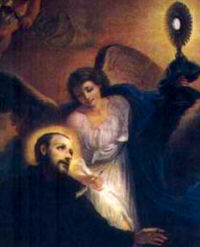Easter: June 4th
Saturday of the Seventh Week of Easter (Vigil of Pentecost)
Other Commemorations: St. Francis Caracciolo, Priest (RM)
» Enjoy our Liturgical Seasons series of e-books!
Entrance Antiphon, Acts 1:14:
The disciples devoted themselves with one accord to prayer with the women, and Mary the Mother of Jesus, and his brethren, alleluia.
The Roman Martyrology today commemorates St. Francis of Caracciolo. Three things made him stand out from his wealthy Neapolitan friends: he was powerfully drawn to our Lord in the Blessed Sacrament, he fasted every Saturday in honor of the Virgin Mary, and he had a generous love for the poor. When he was seriously ill at the age of twenty-two, he vowed that if he were cured he would devote himself to the service of God and his fellow men. He became a priest and in 1588 joined the order of Minor Clerks Regular. Francis instituted perpetual adoration as one of the works of his Order.
>>Continue praying the Pentecost Novena to the Holy Spirit.<<

Vigil of Pentecost
Station with San Giovanni in Laterano (St. John Lateran)
The station is at St. John Lateran because of its baptistery, in days gone by the only place in Rome where the sacrament of baptism was conferred. Formerly it was the custom to baptize at Pentecost those who had been unable to receive this sacrament during the Easter Vigil. That is one of the reasons why all through the Mass there are references to baptismal regeneration by the action of the Holy Spirit.
Click here for a 360 degree virtual tour.
For further information on the Station Churches, see The Stational Church.
Churches of Rome Info: San Giovanni in Laterano Complex.
St. Francis Caracciolo
 Francis founded the Order of Minor Clerks Regular with St. John Augustine Adorno. The congregation's apostolate was preaching missions and performing diverse works of charity. In the course of time he became known as "Venerable Father, the Preacher of the Love of God," a title merited for promoting devotion to the Blessed Sacrament and introducing nocturnal adoration in his community. He had a childlike love for the Blessed Virgin; his greatest joy was to be of service to his neighbor. God endowed him with the gift of prophecy and the discernment of spirits.
Francis founded the Order of Minor Clerks Regular with St. John Augustine Adorno. The congregation's apostolate was preaching missions and performing diverse works of charity. In the course of time he became known as "Venerable Father, the Preacher of the Love of God," a title merited for promoting devotion to the Blessed Sacrament and introducing nocturnal adoration in his community. He had a childlike love for the Blessed Virgin; his greatest joy was to be of service to his neighbor. God endowed him with the gift of prophecy and the discernment of spirits.
At the age of forty-four, while praying one day in the church at Loretto, he recognized that his end was near. Immediately he went to the monastery of Agnona in the Abruzzi, and exclaimed as he entered, "This is my final resting place." Shortly after, he was stricken with fever, received the last sacraments with deepest fervor, and quietly fell asleep in the Lord.
The Church selects our saint's zeal for prayer and his spirit of penance for emphasis in today's Collect, and proposes these two virtues for imitation. "In imitating him grant that we may make such progress that we may pray without ceasing and constantly have our bodies under subjection." This is not an easy task; the liturgy, therefore, provides the needed assistance, the example of St. Francis, and the holy Eucharist.
—Excerpted from The Church's Year of Grace, Pius Parsch
Patronage: Naples, Italy; Italian cooks.
Highlights and Things to Do:
- St. Francis Caracciolo was much sought after as a confessor while his exhortations brought to repentance numerous public sinners, and he fortified the wavering and the despondent by personal encouragement and the recommendation of the two great Catholic devotions, those to the Blessed Sacrament and to Our Lady. Read this longer biography to find out more details about his holiness.
- Learn more about St. Francis Caracciolo:
- Adorno Fathers is one of the orders St. Francis co-founded. See also this website.
- Cook up some Neapolitan (from Naples) type of Italian cooking, such as the Insalata di Rinforzo, as St. Francis is the patron of Italian cooks. He came from a wealthy and powerful family, born in the family castle at Villa Santa Maria in the Abruzzi province of Italy. As a youth he enjoyed hunting and other sports, often entertaining large hunting parties. These parties would have wonderful dinners prepared by the palace chefs. These chefs were so good that they accompanied the family to Naples during the winter season to learn the Naples (Neapolitan) cuisine as well as the Abruzzese.







